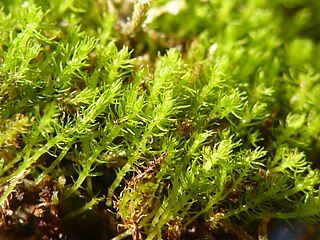
Takakia is a genus of two species of mosses known from western North America and central and eastern Asia. The genus is placed as a separate family, order and class among the mosses. It has had a history of uncertain placement, but the discovery of sporophytes clearly of the moss-type firmly supports placement with the mosses.
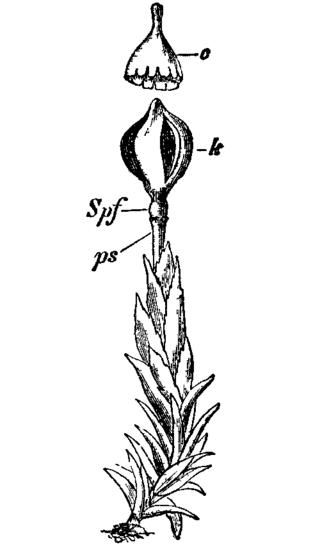
Andreaeaceae is a family of mosses which includes two genera, Andreaea, containing about 100 species, and the genus Acroschisma. The Andreaeaceae prefer rocky habitats ranging from tropical to arctic climates, on which they form tufted colonies, typically with reddish to blackish shoots. The capsules lack the peristome mechanism and dehisce longitudinally to release the spores, resulting in a paper-lantern appearance.
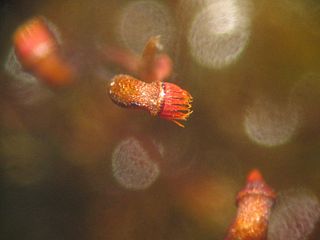
The Bryopsida constitute the largest class of mosses, containing 95% of all moss species. It consists of approximately 11,500 species, common throughout the whole world.

Orthotrichaceae is the only family of mosses in the order Orthotrichales. Many species in the family are epiphytic.

Funariales is an order containing 356 species, 26 genera and 7 families.
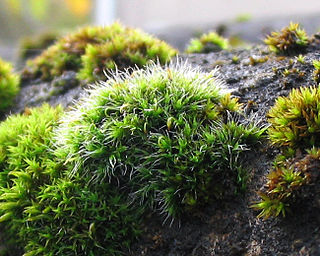
Grimmiales is an order of mosses in the subclass Dicranidae. It comprises four families: Grimmiaceae, Ptychomitriaceae, Seligeriaceae, and Saelaniaceae.

Sphagnopsida is a class of mosses that includes a single subclass Sphagnidae, with two orders. It is estimated it originated about 465 million years ago, along with Takakia. The order Sphagnales contains four living genera: Ambuchanania, Eosphagnum, and Flatbergium, which counts four species in total, and Sphagnum which contains the rest of the species. The extinct Protosphagnales contains a single fossil species.
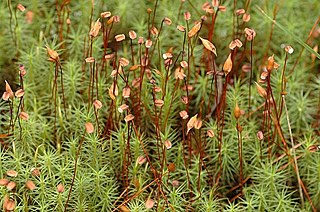
Polytrichaceae is a common family of mosses. Members of this family tend to be larger than other mosses, with the larger species occurring in particularly moist habitats. The leaves have specialized sheaths at the base and a midrib that bears photosynthetic lamellae on the upper surface. These mosses are capable of sustaining high rates of photosynthesis in the presence of ample light and moisture. Unlike all other mosses, the hydroid-based vascular system of these mosses is continuous from stem to leaf and can extract water from the soil through transpiration. Species in this group are dioicous, though some are monoicous. In most species, the sporophytes are relatively large, the setae are rigid, and the calyptrae are hairy. Most species have nematodontous peristomes with 32–64 teeth in their sporangium; some early-diverging genera instead have a stopper mechanism, which consists of the apical section of the columella, that seals the mouth of the capsule shut prior to dehiscence.

The Funariidae are a widespread group of mosses in class Bryopsida. The majority of species belong to the genera Funaria and Physcomitrium.

Pottiales is an order of mosses in the subclass Dicranidae.

Seligeriaceae is a family of mosses in the subclass Dicranidae.
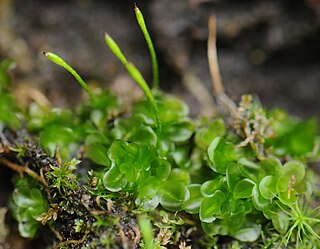
Oedipodium is the only genus of moss in the family Oedipodiaceae. It contains the single species Oedipodium griffithianum, the gouty-moss or Griffith's oedipodium moss. This species is distributed in cooler climates of Eurasia, as well as from Alaska, Washington state, British Columbia, Yukon, Greenland, Newfoundland, Tierra del Fuego and the Falkland Islands.
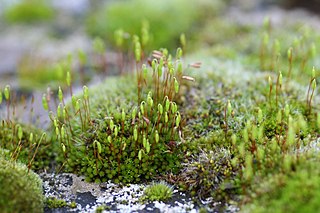
Bryales is an order of mosses.

The Funariaceae are a family of mosses in the order Funariales. About 303 species are included in the family, with 200 species in Funaria and another 80 classified in Physcomitrium.
Gigaspermaceae are a family of mosses in the monotypic order Gigaspermales. The order is placed in subclass Gigaspermidae of the class Bryopsida. They were previously placed in subclass Funariidae.

Encalyptales is an order of mosses in subclass Funariidae. It contains a single family.

Timmia is a genus of moss. It is the only genus in the family Timmiaceae and order Timmiales. The genus is named in honor of the 18th-century German botanist Joachim Christian Timm.

Bryaceae is a family of mosses.
Neosharpiella is a genus of moss containing two species in the family Bartramiaceae. The type species, Neosharpiella aztecorum, grows in alpine regions of central Mexico, while the other species, Neosharpiella turgida, has been found in Bolivia and Ecuador.
William Russel Buck is an American bryologist.















